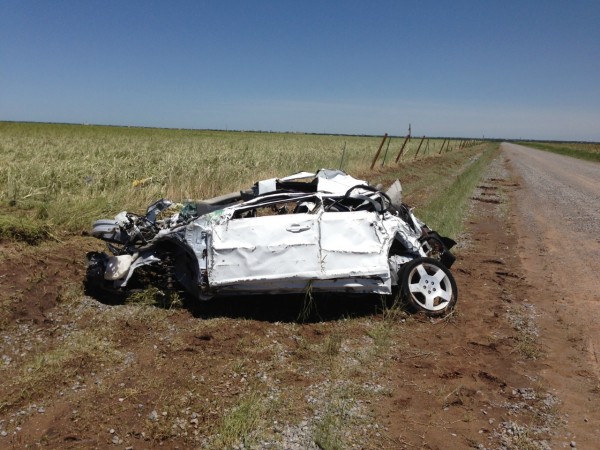The El Reno Tornado
The El Reno, Oklahoma Tornado occurred on this date two years ago. It was a game changer for storm chasers.
The event had been well forecast. Hundreds of chasers had converged on the small community in Canadian County, Oklahoma. A thunderstorm developed in the explosively unstable environment, going from relatively harmless cumulus clouds to a powerful supercell thunderstorm extending more than 60,000 feet into the atmosphere.
The tornado touched down at 6:03 p.m. about 8 miles west southwest of El Reno and lumbered slowly southeast. Almost immediately, it was already a wedge, the visible funnel beneath the cloud base wider than it was tall.
Researcher and storm chaser Tim Samaras, his son Paul and Carl Young were monitoring the storm from a position about 2.5 miles to its northeast. By 6:09, the tornado was already rain wrapped, obscuring its true intentions from chasers. It was accelerating and turning east just south of Reno Road approaching Brandley Road. Samaras and his team were struggling to get ahead of the fast moving tornado as they navigating, south, then east and then north, just out of the tornado’s reach as it raced east at over 40 mph, growing to nearly two miles wide.
By 6:16, Samaras and his team had turned east on Reuter Road, a major east-west artery. They were less than a mile north of the edge of the tornado. It was still zigzagging east southeast, but it was growing even larger. It took them three minutes to make it to US-81, the main north-south road in the area. They paused there for a moment. The tornado was nearly 2.5 miles wide at this point, the edge of the swirling mass obscured in heavy rain and less than a quarter mile south of them, and it was turning to the northeast.
Unbeknownst to Samaras’ TWISTEX team, as they continued east on Reuter Road, they were heading into the teeth of a monster. Speeding east, they began to encounter intense 70 mph head winds on the left side of the tornado that slowed their progress. The tornado was holding them back with its outer circulation, the winds in the powerful vortex approaching 300 mph according to Doppler radar data.
Before the TWISTEX crew reached Radio Road, their path intersected the tornado. There, a subvortex intercepted their White Chevy Cobalt and threw the car over 2,000 feet. It was recovered in a field east of the intersection of Reuter Road and Radio Road. Tim was found in the crushed car. The engine and three of the wheels were missing. Paul and Carl’s bodies were recovered near where the subvortex hit the car.

National Weather Service Office in Norman, Oklahoma – https://www.srh.noaa.gov/oun/?n=events-20130531-damagephotos
The El Reno Tornado was a terrible beast. Some of the frightening superlatives noted by the Doppler on Wheels according to Josh Wurman:
…As it neared Highway 81, it was moving at 55 mph. This contributed to the deaths of the TWISTEX team as the massive tornado overtook them.
…Subvortices inside the parent tornado were as large as other major tornadoes.
…There were actually tornadoes within other tornadoes.
…The DOW actually recorded a 255 mph velocity in a subvortex! (That’s the equivalent of an EF5 rating).
…The official width of the tornado was 2.6 miles, making it the largest on record. But the circulation was actually 4.3 miles wide at 300 feet according to the radar!
…The powerful circulation produced an anticyclonic tornado with winds measured at 145 mph.
It’s human toll was great: nine people lost their lives during the storm.
It was initially rated as an EF5, but that rating was surprisingly lowered to an EF3. Velocities measured by the DOW were well above the threshold for an EF5 rating, but the rating scale is a damage scale and since the tornado did not leave damage indicators that were consistent with those wind speeds, the official rating of the tornado went into the books as an EF3. Many argued that the reliable Doppler radar data gathered during the El Reno Tornado supported the EF5 rating.
One thing the El Reno Tornado did was remind thousands of professional and amateur storm chasers that the violent storms are unpredictable and deadly. Tim Samaras was widely known as one of the most respected and safest chasers in the business. If he could die in a storm, then it could happen to anyone.
Category: Met 101/Weather History


















